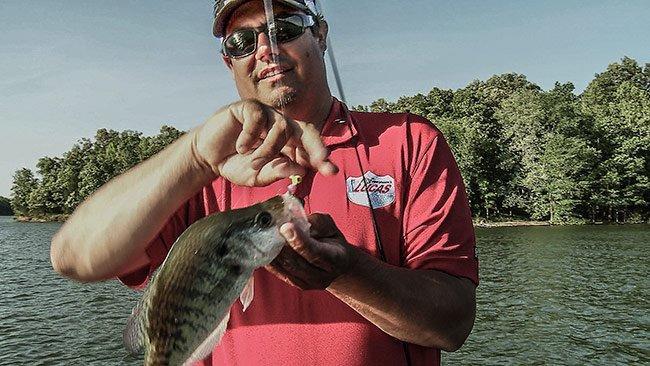Most serious crappie fishermen change their tactics with the seasons, not because they want to, but because the body of water and target species necessitate it. However, some anglers find something they like and stick to it. Not all tactics can be successful all year, but long-line trolling is one crappie fishing exception.
Anglers generally long-line troll, or “pull,” by securing rod and reels in stationary rod racks and letting line out behind the boat, pulling 1/32 to 1/4-ounce jigs at various depths and speeds through likely areas with a trolling motor.
The 2-time National Champion team of Travis and Charles Bunting are far from one-trick ponies and have utilized about every tactic in the book to catch crappie, but they claim long-line trolling as one of their favorites because of its effectiveness all year on any body of water.
“Long-lining is basically casting and retrieving, but you’re letting the boat do the cranking, and you can use multiple rods to get more baits in various depths and spreads to increase your chances of catching fish,” said Travis Bunting.
Time of year
Long-line trolling can be successful during all four seasons, but adjustments are necessary to match the mood of the crappie. Here are tips for each season:
- Winter is probably the toughest time for conventional long-liners due to the crappie being lethargic and less apt to chase a bait. The key here is to slow down and vary size and color, as there will often be particular baits that will garner more aggressive strikes than others. Starting with small, 1/32-ounce heads and small profile baits are generally best.
- Spring long-lining finds anglers in the shallowest waters of the year. Although long-lining isn’t feasible shallower than 2 feet, 4- to 8-foot deep water can be very productive.
“As long as there’s enough light penetration, the crappie will spawn. That’s why fish spawn deeper in clear lakes than stained or muddy lakes,” Bunting said. Mid-sized, 1/16 to 1/8-ounce heads and bright colors are good choices. - Summer plays right into the long-liners hands, when larger profile baits at faster speeds consistently produce more crappie. The Buntings will use two, 1/8 or ¼-ounce jigheads per line with 2 ½-inch plastics and increase their speed during the hot months.
- Fall is the best time to target schooling crappie that are aggressively feeding. The Buntings will scan areas looking for baitfish in likely areas.
“We like to target balls of baitfish that are broken up,” Travis said “That lets us know crappie are actively feeding and disturbing those baitfish.

Where to Long-line
Long-lining can be done in nearly any water, with the only snag being, well, snags. In areas with heavy cover, keeping the baits just above the cover is key for both catching fish and avoiding hang-ups.
- Flats are the best areas to longline on most waters and during most of the year. The Buntings prefer 10-15 feet deep flats at the back of creeks.
- Ledges can be productive for crappie transitioning from deep water to flats or shallower spawning grounds.”We will scan ledges and look for cover that’s holding fish, and then pull baits right across the top of the cover,” Travis said.
- Main channels will occasionally hold suspended crappie, and making wide swaths pulling multiple baits is a great way to target these fish.
Speed is key
The Buntings always start out at 0.8 mph and have found that this speed will work most of the time. If the bite is inactive, they will make “S” curves with the boat. This reduces the speed of the lures on the poles on the inside of the “S” and increases lure speed on the outside. If they pick up fish on one or the other side they know if they need to slow down or speed up.
Depth is determined by speed, length of line out, lure weight and drag. While there are formulas that will give exact directions to attain a given depth with any size lure, the Buntings, like most, take a simpler approach.
“I’ll take the inside pole and cast it out behind the boat, then pull one arm’s length (about 4-foot) and flip the bail. On the second pole, I’ll pull 2 arm lengths and 3 on the third. This gives us enough variance combined with speed alterations to hone in on the fish.”
If their baits are hitting the bottom or snagging on cover, they’ll reel up until they’re above it.

Setting up for success
Gear does not have to be complicated for long lining crappie. Here are some suggestions from the Buntings to get you started.
- Terminal tackle – 1/32 to 1/4-ounce jig heads are going to cover most all scenarios, and tying on two jigs 3 or 4 feet apart is a common way to increase your chances. Roadrunner heads are the most popular choice among long-liners due to the blade creating additional flash and vibration. The exception is winter fishing when pulling small baits at slower speeds is more effective. The Roadrunner head will create more drag and come up in the water column more than regular jigheads.
- Bait – Plastics are by far the best choice for long-lining due to the options available and ease of changing colors or styles. The Buntings are proponents of big baits, especially when moving fast, and will vary between the 2 1/2-inch Muddy Water Baits on regular jigheads for less vibration, and Southern Pro Hot Grubs on Roadrunner heads for more vibration.
- Color – The go-to colors for long-lining are no surprise, with black and chartreuse, white and chartreuse, and lime and chartreuse dominating the rest. As always, clearer water necessitates more natural and translucent colors, and stained to muddy water calls for solid and brighter colors.
- Line – The Buntings depend on Hi-vis Vicious Panfish line in 6 to 10-pound depending on the probability of hang-ups.
- Rod Racks – While long-lining can be done out of the back or the side of the boat, the Buntings run their rods from stationary, Tite-loc rod racks in the front of the boat.
“We depend heavily on the Humminbird 360 on the bow, the ability to see what’s coming up ahead of us is vital to our success on the water, so we run our rods from the front,” Travis said.Any stationary rod racks will serve the purpose, and anglers who are limited to one or two poles can hold them while the trolling motor does the work of pulling the bait through the water. - Rods and reels – Long-lining is generally done with light weights, so most crappie rods will work for this tactic. The key is to keep at least 4 feet of separation between each rod tip. The Buntings use B’n’M 6-foot, 6-inch spinning rods on the inside poles, and 10- and 14-foot B’n’M BGJPs for the middle and outside rods. Any small spinning reels will work for this tactic, with consideration to line capacity and a smooth drag.
Long-line trolling is a fairly simple tactic that can be employed on lakes and rivers all over the country during all four seasons. These tips hopefully will help you put crappie in the boat all year long.

















